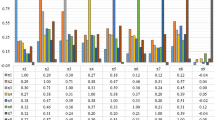Abstract
In this paper we present the decision rules of a two-stage binary Bayesian classifier. The loss function in our case is fuzzy-valued and is dependent on the stage of the decision tree or on the node of the decision tree. The decision rules minimize the mean risk, i.e., the mean value of the fuzzy loss function. The model is first based on the notion of fuzzy random variable and secondly on the subjective ranking of fuzzy number defined by Campos and González. In this paper also, influence of choice of parameter λ in selected comparison fuzzy number method on classification results are presented. Finally, an example illustrating the study developed in the paper is considered.



Similar content being viewed by others
References
Berger J (1993) Statistical decision theory and Bayesian analysis. Springer, Berlin Heidelberg New York
Baas S, Kwakernaak H (1997) Rating and ranking of multi-aspect alternatives using fuzzy sets. Automatica 13:47–58
Gil M, López-Díaz M (1996) Fundamentals and Bayesian analyses of decision problems with fuzzy-valued utilities. Int J Approx Reason 15:203–224
Gil M, López-Díaz M (1996) A model for Bayesian decision problems involving fuzzy-valued consequences. In: Proceedings of 6th international conference on information processing and management of uncertainty in knowledge based systems, Granada, pp 495–500
Jain R (1976) Decision-making in the presence of fuzzy variables. IEEE Trans Syst Man Cybern 6:698–703
Viertl R (1996) Statistical methods for non-precise data. CRC Press, Boca Raton
Kurzyński M (1983) Decision rules for a hierarchical classifier. Pattern Recognit Lett 1:305–310
Kurzyński M (1988) On the multistage Bayes classifier. Pattern Recognit 21:355–365
Campos L, González A (1989) A subjective approach for ranking fuzzy numbers. Fuzzy Sets Syst 29:145–153
Adamo JM (1980) Fuzzy decision trees. Fuzzy Sets Syst 4:207–219
Yager R (1981) A procedure for ordering fuzzy subsets of the unit interval. Inf Sci 22:143–16
López-Díaz M, Gil MA (1998) The λ-average value of the expected value of a fuzzy random variable. Fuzzy Sets Syst 99:347–352
Kurzyński M, Masaryk P, Svec V (1989) Multistage recognition system applied to the computer-aided diagnosis of some rheumatics diseases. Syst Sci Wrocław 15:59–66
Author information
Authors and Affiliations
Corresponding author
Rights and permissions
About this article
Cite this article
Burduk, R., Kurzyński, M. Two-stage binary classifier with fuzzy-valued loss function. Pattern Anal Applic 9, 353–358 (2006). https://doi.org/10.1007/s10044-006-0043-9
Received:
Accepted:
Published:
Issue Date:
DOI: https://doi.org/10.1007/s10044-006-0043-9




